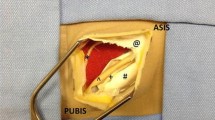Abstract
Background
The totally extraperitoneal technique (TEP) is a well-established method for repairing inguinal hernias laparoscopically. It has a low recurrence rate with minimal morbidity. Good training is necessary to decrease the length of the learning curve. Laparoscopic training courses at the Guildford Minimal Access Therapy Training Unit (MATTU) include lectures, live demonstrations, and practical training. In the absence of a commercially available TEP hernia model, the Guildford MATTU, along with Limbs and Things, has developed a realistic artificial model. Objective: The aim was to develop a model that would familiarize course participants with the different anatomical perspective and the steps needed to complete the TEP repair, in an effort to shorten their learning curve. Evaluation: The MATTU model has been evaluated in terms of anatomic accuracy, realism, versatility, cost effectiveness, and ease of use.
Conclusions
The MATTU model accurately replicates TEP repair. It is robust, easy to use, cost effective, and easy to maintain. It will be widely available.
Similar content being viewed by others
References
Barrat C, Voreux JP, Occelli G, Catheline Jm, Champault G (1999) Influence de la formation chirurgicale et de l’apprentissage sur les resultats du traitement laparoscopique des hernies de l’aine. Chirurgie 124: 298–303
Kopchok GE, Cavaye DM, Klein SR, Mueller MP, Lee JL, White RA (1993) Endoscopic surgery training: application of an in vitro trainer and in vivo swine model. J Invest Surg 6: 329–337
Layman TS, Burns RP, Chandler KE, Russell WL, Cook RG (1993) Laparoscopic inguinal herniorrhapy in a swine model. Am Surg 59: 13–19
Liem MSL, van der Graaf Y, van Steensel CJ, Boelhouwer Ru, Clevers GJ, Meijer MS, Stassen LP, Vente JP, Weidema WF, Schrijvers AJ, van Vroonhoven TJ (1997) Comparison of conventional anterior and laparoscopic inguinal hernia repair. N Engl J Med 336: 1541–1547
Liem MSL, van Steensel CJ, Boelhouwer RU, Weidma WF, Cleyers GJ, Meijer WS, Vente JP, de Vries LP, Vroonhoven TJ (1996) The learning curve for totally extraperitoneal laparoscopic inguinal hernia repair. Am J Surg 171: 281–285
Liem MSL, van Vroonhoven ThJMV (1996) Laparoscopic inguinal hernia repair. Br J Surg 83: 1197–1204
Royston CMS, Lansdown MRJ, Brough WA (1994) Teaching laparoscopic surgery: the need for guidelines. BMJ 308: 1023–1025
Stoppa RE, Waralaumont CR (1989) The preperitoneal approach and prosthetic repair of groin hernia. In: Nyhus LM, Condon RE (eds) Hernia. 3rd ed. JB Lippincott, Philadelphia, pp 199
Vogt D, Ellersieck M (1990) Heritability of susceptibility to scrotal herniation in swines. Am J Vet Res 51: 1501–1503
Wellwood J, Sculpher MJ, Stoker D, Nicholls GJ, Geddes C, Whitehead A, Singh R, Spiegelhalter D (1998) Randomised controlled trial of laparoscopic versus open mesh repair for inguinal hernia: outcome and cost. BMJ 317: 1003–1010
Author information
Authors and Affiliations
Additional information
Online publication: 6 February 2001
Rights and permissions
About this article
Cite this article
Slater, G.H., Jourdan, I., Fölscher, D.J. et al. The Guildford MATTU TEP hernia model. Surg Endosc 15, 493–496 (2001). https://doi.org/10.1007/s004640000361
Received:
Accepted:
Published:
Issue Date:
DOI: https://doi.org/10.1007/s004640000361




